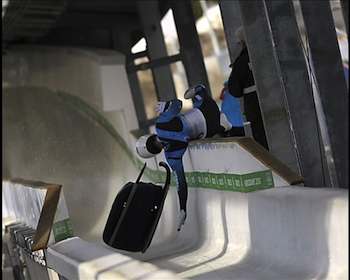- MENU
- HOME
- SEARCH
- WORLD
- MAIN
- AFRICA
- ASIA
- BALKANS
- EUROPE
- LATIN AMERICA
- MIDDLE EAST
- United Kingdom
- United States
- Argentina
- Australia
- Austria
- Benelux
- Brazil
- Canada
- China
- France
- Germany
- Greece
- Hungary
- India
- Indonesia
- Ireland
- Israel
- Italy
- Japan
- Korea
- Mexico
- New Zealand
- Pakistan
- Philippines
- Poland
- Russia
- South Africa
- Spain
- Taiwan
- Turkey
- USA
- BUSINESS
- WEALTH
- STOCKS
- TECH
- HEALTH
- LIFESTYLE
- ENTERTAINMENT
- SPORTS
- RSS
- iHaveNet.com
Mitch Albom

I've been on a luge sled. And I've crashed.
I've felt my jaw vibrate as my helmet dribbled on the ice. Felt my shoulders smack against the walls of a straightaway. Felt the discombobulation of looking down over my feet as I tried desperately to steer, pinballing off the sides, finally separating from the sled and scraping my butt down the frozen track.
I was younger then and traveling with the U.S. luge team through
The luge community in those days was small, tight, brave and low-tech, like the fighter pilots who pioneered our space program. The Americans mostly stayed in cheap hotels, slept three to a room, traveled in a van, ate candy bars for training and fixed their own sleds. They were funny, grubby, detail-oriented and fearless -- their love of speed was
The words "he came out of the track."
The drama of speed and g-forces
You never wanted to do that. It was almost impossible. The gravitational forces of going 70 or 80 m.p.h. slammed you into the ice (they are what bounce your helmet during the curves) and while you can smack and bruise yourself all over the serpentine walls, you are pretty much in the track to stay.
But there is a brief window, a split second really, coming out of a curve, where the walls get low and where it is possible, if you lose control and are going too fast and the ice gods are not with you, that you could go airborne and fly out of the track.
Which is what happened to an Olympic luger Friday morning, during a training run, on the day the Vancouver Winter Games were to begin. His
name was Nodar Kumaritashvili, from the former
When I crashed, I was going 30 m.p.h.
He was going almost 90.
And he's dead.
"He came out of the track." When
Because of that, people need to understand.
This is tragic. But it is not typical.
The desire to place blame
Luge is not a place to die. Mortality incidents, considering the sport -- no pads, only a helmet, lying supine on a speeding sled -- are exceedingly rare.
But several forces are at work here. First is the unquenched thirst for faster tracks. I don't know why the
Also -- and this went on 25 years ago when I covered the sport -- host countries often limit practice time for foreign teams, hoping to preserve a home-ice advantage. Apparently, this went on in
But beyond that -- although an international media will no doubt blow this thing up and scold everyone in sight -- mostly this was luge being luge, a dangerous canvass with a small rip that in the worst combination of circumstances can suck up an athlete and take him away.
"He came out of the track." The voices soften. The eyes lower. Only this time, the whole world was watching and is not likely to forget.
2010 Vancouver Winter Olympic Games
A Ghost that Hovers Over the Icy Luge Track